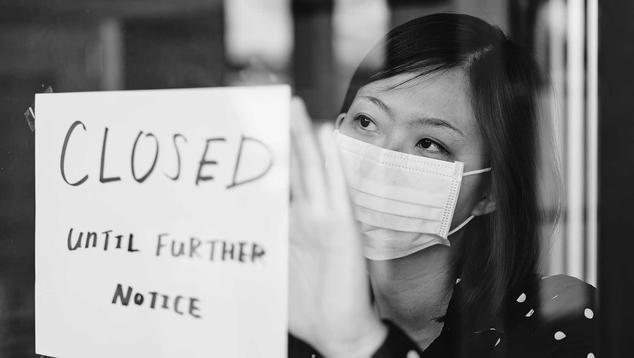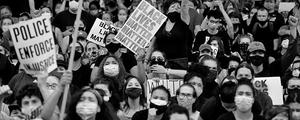Story Highlights
- Fewer than 1 in 4 Americans see economy doing well
- A third believe economy is improving, but most still say it's worsening
- Economic ratings not as low as during worst of 2007-2009 recession
WASHINGTON, D.C. -- After sliding in March and April, Americans' ratings of the nation's economy remained low in May and have not improved at the start of June. The latest poll was conducted May 28-June 4, just prior to the federal May jobs report showing an unexpected decline in unemployment.
According to the poll, fewer than one in four U.S. adults, 23%, rate current economic conditions as excellent or good, essentially tying last month's low point, the lowest that Gallup has recorded during the coronavirus pandemic. At the same time, while also low, more Americans today (33%) than in April (22%) think the economy is getting better.

Line graph. Monthly trends from May 2019 to May 2020 in Americans' perceptions that current economic conditions are excellent or good and that the economy is getting better. After peaking above 60% in February 2020, positive perceptions on both measures fell below 30% in April and remain low in May and June.
The fact that more Americans today than two months ago believe the economy is improving may reflect the partial reopening of commerce in most states since Memorial Day. However, it is still a long way from signaling that Americans perceive the economy to be on the verge of a comeback.
Even with Americans' slightly improved outlook for the economy, their assessments remain much less positive than at the start of the year when economic confidence was the highest Gallup had seen since 2000.
Ratings Have Been Worse in the Past
Gallup has recorded much worse economic ratings than now in the past, both during and after the 1991 and 2007-2009 recessions. For example, in contrast to the 36% rating conditions poor today, the figure averaged 50% during the 2007-2009 recession, including a 73% high point. In 1992, shortly after the 1991 recession, between 41% and 53% rated economic conditions as poor.
Additionally, although Americans' positive ratings of the economy stayed the same in June as in May, their negative ratings became a bit less negative. Over the past month, the percentage rating conditions as poor fell from 42% to 36% while the percentage rating them only fair rose from 35% to 41%.
| May 28-Jun 4, 2020 | May 1-13, 2020 | Feb 3-16, 2020 | Oct 10-12, 2008 | ||||||||||||||||||||||||||||||||||||||||||||||||||||||||||||||||||||||||||||||||||||||||||||||||
|---|---|---|---|---|---|---|---|---|---|---|---|---|---|---|---|---|---|---|---|---|---|---|---|---|---|---|---|---|---|---|---|---|---|---|---|---|---|---|---|---|---|---|---|---|---|---|---|---|---|---|---|---|---|---|---|---|---|---|---|---|---|---|---|---|---|---|---|---|---|---|---|---|---|---|---|---|---|---|---|---|---|---|---|---|---|---|---|---|---|---|---|---|---|---|---|---|---|---|---|
| % | % | % | % | ||||||||||||||||||||||||||||||||||||||||||||||||||||||||||||||||||||||||||||||||||||||||||||||||
| Excellent | 4 | 4 | 24 | 1 | |||||||||||||||||||||||||||||||||||||||||||||||||||||||||||||||||||||||||||||||||||||||||||||||
| Good | 19 | 18 | 39 | 4 | |||||||||||||||||||||||||||||||||||||||||||||||||||||||||||||||||||||||||||||||||||||||||||||||
| Only fair | 41 | 35 | 28 | 22 | |||||||||||||||||||||||||||||||||||||||||||||||||||||||||||||||||||||||||||||||||||||||||||||||
| Poor | 36 | 42 | 9 | 73 | |||||||||||||||||||||||||||||||||||||||||||||||||||||||||||||||||||||||||||||||||||||||||||||||
| Gallup | |||||||||||||||||||||||||||||||||||||||||||||||||||||||||||||||||||||||||||||||||||||||||||||||||||
Similar perspective can be brought to bear on Americans' outlook for the economy. Whereas 33% today believe the economy is getting better and 62% getting worse, the negative outlook averaged 78% throughout the 2007-2009 recession, reaching as high as 87% in June 2008.
In other words, as much as optimism about the economy has slid since February, the metric has shown the capacity to go much lower.
| May 28-Jun 4, 2020 | May 1-13, 2020 | Feb 3-16, 2020` | Jun 9-12, 2008 | ||||||||||||||||||||||||||||||||||||||||||||||||||||||||||||||||||||||||||||||||||||||||||||||||
|---|---|---|---|---|---|---|---|---|---|---|---|---|---|---|---|---|---|---|---|---|---|---|---|---|---|---|---|---|---|---|---|---|---|---|---|---|---|---|---|---|---|---|---|---|---|---|---|---|---|---|---|---|---|---|---|---|---|---|---|---|---|---|---|---|---|---|---|---|---|---|---|---|---|---|---|---|---|---|---|---|---|---|---|---|---|---|---|---|---|---|---|---|---|---|---|---|---|---|---|
| % | % | % | % | ||||||||||||||||||||||||||||||||||||||||||||||||||||||||||||||||||||||||||||||||||||||||||||||||
| Getting better | 33 | 31 | 61 | 8 | |||||||||||||||||||||||||||||||||||||||||||||||||||||||||||||||||||||||||||||||||||||||||||||||
| Getting worse | 62 | 67 | 33 | 87 | |||||||||||||||||||||||||||||||||||||||||||||||||||||||||||||||||||||||||||||||||||||||||||||||
| Staying the same (vol.) | 3 | 2 | 5 | 4 | |||||||||||||||||||||||||||||||||||||||||||||||||||||||||||||||||||||||||||||||||||||||||||||||
| No opinion | 1 | 1 | 1 | 1 | |||||||||||||||||||||||||||||||||||||||||||||||||||||||||||||||||||||||||||||||||||||||||||||||
| Gallup | |||||||||||||||||||||||||||||||||||||||||||||||||||||||||||||||||||||||||||||||||||||||||||||||||||
Bottom Line
Even before economists this week declared the U.S. economy to be in a recession, 71% of Americans believed the economy was in a recession or a depression and were expressing drastically reduced confidence in the economy compared with the start of the year.
Knowing the economy is in a recession could send Americans' economic confidence even lower in July. An almost assuredly grim second-quarter report on Gross Domestic Product may only exacerbate this pessimism. On the other hand, if the June jobs data reported next month denotes further declines in unemployment, or if this month's federal retail sales report shows a surge in consumer spending, many more Americans may believe the economy is improving. Regardless, as suggested by the recent stagnation in ratings of current conditions, it may take longer for consumers to perceive that the actual performance of the economy is strong than to perceive conditions are improving.
View complete question responses and trends (PDF download).
Learn more about how the Gallup Poll Social Series works.




